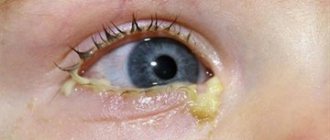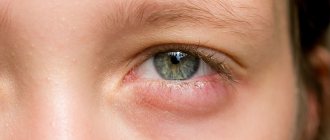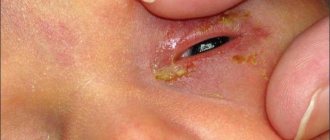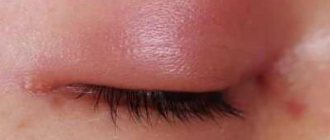What are the symptoms and types of colds on the eye?
A cold on the eye is familiar to many people firsthand. The inflammatory process can affect not only the eyelids, but also the mucous membrane. There are many reasons that cause inflammation in the eye area. As a rule, such discomfort is a consequence of the activity of bacteria and viruses. It is preceded by the following factors:
- Avitaminosis;
- Hypothermia or overheating;
- Weakening of the immune system;
- Various inflammatory or infectious diseases;
- Hypovitaminosis;
- Unbalanced diet;
- Stress, depression, chronic fatigue;
- Hormonal disorders, fatigue.
There are no difficulties in determining the form of a cold on the organs of vision during diagnosis. Often an initial examination is enough for the doctor to recognize a viral infection, but sometimes the patient requires additional consultation with specialists such as a therapist, allergist, immunologist and dermatologist.
If the doctor has suspicions about making the correct diagnosis for a cold of the eye, the patient is prescribed additional tests - ultrasound of the visual apparatus, biomicroscopy, non-contact tonometry, visometry, ophthalmoscopy and/or gonioscopy.
The doctor may also resort to laboratory analysis, after first taking the necessary samples from the mucous membrane (this can be a scraping or a smear).
A cold can be expressed as an acute form of inflammation, localized in the area of the sebaceous gland of the eyelid. Along with adults, children often suffer from this type of disease. These ophthalmopathologies can manifest themselves in the form of barley, herpes rashes or conjunctivitis. The appearance of these diseases is provoked by specific pathogens. Pathogenic bacteria and viruses are regularly present in the human body, but their numbers and activity are regulated by the immune system. When the natural protective functions of the body decrease, a favorable time comes for microorganisms that are instantly activated.
Lack of hygiene, the habit of rubbing your eyes with dirty hands, diseases of the digestive tract (for example, gastritis), diabetes mellitus - these factors also contribute to the appearance of inflammatory processes.
Eye viruses can attack a person unexpectedly, but a cold under the eye is not a reason to panic, since there are many medications that can quickly get rid of unwanted manifestations.
Perhaps the most common eye disease is conjunctivitis, i.e. an inflammatory process localized in the mucous membrane or in the inner parts of the eyelids. Most often, this disorder occurs on an infectious basis, but often the cause of its occurrence is mechanical damage to the eye or allergies. Conjunctivitis is caused by adenovirus, herpes, various fungi and bacteria of different groups. In the acute phase of the inflammatory process, the patient complains of pain, discomfort, purulent discharge, deterioration of health (headache, fever). There are two ways to become infected with this disease: contact or airborne transmission. Therefore, quarantine is recommended for patients (isolation is especially necessary if an adult is in contact with children). The active phase of inflammation can last up to three weeks.
Stye, or hordeolum, is another common manifestation of a cold on the eyelid, implying inflammation of the sebaceous gland or hair follicle, appearing in the form of a purulent formation. Unlike conjunctivitis, stye is not contagious. It occurs due to the active proliferation of Staphylococcus aureus, which the body fights, resulting in tissue inflammation. Swelling and redness occur at the site of infection. Often, when treating gordeloma, ophthalmologists are faced with a situation where the patient’s eye is severely swollen and due to deformations on the eyelid, the view is partially or completely blocked. With barley, the patient complains of itching, accompanied by pain at the site of the rash. 2-4 days after infection, an abscess appears at the site of infection, which in most cases breaks out spontaneously after 3-7 days.
If the pus does not come out naturally for a long time, the stye turns into a so-called chalazion - a hard formation that can retain its shape for up to 2 months.
The herpes simplex virus can cause ophthalmoherpes. The symptoms of this disease are similar to those described above: the eye turns red during a cold, swelling occurs, a sensation of a foreign body, increased temperature and lacrimation, itching, etc. Such rashes can be localized not only on the eyelids or in the area of the lacrimal canal, but also on the cornea, causing clouding and damaging its surface. Ocular herpes is dangerous because it easily spreads to other unaffected areas. It is especially difficult in children.
How to relieve nasal swelling during pregnancy?
You can relieve nasal swelling during pregnancy, if it occurs as a result of infection, in the following ways:
- Rinse each sinus with sea salt . They help to quickly reduce swelling. You can buy a ready-made solution at the pharmacy.
- Drink plenty of fluids . It will help prevent possible dehydration. It is recommended to use lingonberry or cranberry fruit drinks without added sugar.
- Taking antibacterial and antiviral drugs . The treatment regimen is prescribed by a doctor.
Important to remember ! During pregnancy, you can visit a physiotherapy room.
The most effective are ultrasonic inhalations, for enhancement with a solution of medicinal plants, antiviral and antibacterial drugs, and saline solution.
During pregnancy, it is strictly forbidden to use heat treatment , steam your feet, or bask in a hot bath or sauna.
What to do if you have a cold in your eye?
If cold symptoms appear on the eye, it is necessary to consult a specialist who will thoroughly explain how to treat the inflammatory process correctly and what medications are best to use. In recurrent forms, ocular inflammation is treated by an ophthalmologist in tandem with an immunologist and a therapist. In some cases, after diagnosis, the patient is prescribed a regimen of antibiotics, special forms of anti-inflammatory drugs, antiseptics, ointments, and antimicrobial eye drops. To speed up the recovery process, pharmacy vitamin complexes can be prescribed.
In the vast majority of cases, colds of the eyes disappear within 7-10 days. The healing process can occur without medication intervention
To eliminate the risk of complications, doctors still recommend not ignoring the symptoms that appear and seeking advice. To make the cold go away faster, the ophthalmologist, depending on the situation, may prescribe:
- UHF heating (the use of additional dry heat is allowed at the initial stages of the inflammatory process);
- Using special bactericidal soap when washing;
- Treating the affected area with medications (including eye drops).
If an abscess forms, it is extremely undesirable to try to get rid of it yourself by applying pressure - opening should occur naturally, as the abscess matures. If, after 7 days of eye infection due to a cold, the pus does not begin to come out on its own, and a thickened swelling is observed at the site of its formation, the patient should consult a specialist. A similar decision should be followed in cases where the formation increases in size and this symptom is accompanied by pain.
It is extremely important that during the inflammatory process a person uses a separate towel and other personal hygiene items. This rule must be followed regardless of whether the disease is transmitted by airborne droplets or contact. For example, with barley, which itself is not contagious, a staphylococcal infection can spread quite easily.
How to treat a cold on a child's eye?
Children's bodies are characterized by reduced immune activity due to the endocrine system not being fully formed. Therefore, children often suffer from eye colds, especially conjunctivitis. A cold in a child's eye can manifest as redness, lacrimation, swelling of the conjunctiva, itching and burning, photophobia and pain. It is important for parents to understand that a cold in a child’s eye is a good reason to contact a pediatrician, who, during the examination, will identify irritating factors and also establish the etiology of the disease. If cold symptoms appear in a young patient under one year of age, a specialist, as a rule, prescribes drops, the list of active ingredients of which contains mainly harmless herbal components.
How to quickly relieve swelling of the nasal mucosa with a runny nose or allergies?
Swelling can occur due to a viral disease or an allergic reaction. In this case, you need to consult a doctor who will prescribe antiviral drugs.
If you have an allergy, it is necessary to limit or completely eliminate contact with the suspected allergen.
Below are drugs and medications that will help quickly relieve swelling of the nasal mucosa. They are sold in pharmacies without a prescription.
| Name of drops | Efficiency of application |
| "Allergodil", "Suprastin", "Cromohexal" | The composition contains histamine (an active substance), which quickly blocks receptors. Used for allergies even at the initial stage of mucosal swelling |
| "Dolphin", "Aquamaris", "Saline" | The base is sea water. They help relieve even severe swelling |
| Naphthyzin analogues: “Dlyanos” and “Nazivin” | These are anticongestants and adrenergic agonists with a broad spectrum of action. They effectively eliminate swelling in case of a viral disease and allergic reaction, as well as if the nose is stuffy. They differ in their temporary action. Cannot be used for a long time because there is a high probability of vascular spasms |
What you need to know about preventing eye diseases?
Colds of the eyes are easier to prevent than to treat. Good prevention will be following the rules of hygiene and adherence to a healthy lifestyle, which helps maintain a person’s immune system in good condition. Doctors recommend playing sports, taking walks in the fresh air, eating right (including fruits and vegetables in your diet), alternating work and rest, and, of course, whenever possible, giving up bad habits.
It is strictly prohibited to use personal belongings of a sick person, be it a towel, washcloth, cosmetics, contact lenses or clothing.
It is not recommended to touch the organs of vision with unwashed hands, and also to trigger ENT diseases. To prevent deterioration of vision due to inflammatory processes, treatment should be started in a timely manner (the acuity of world perception is affected by frequent relapses of colds).
Doctors advise further stimulating the immune system after recovery from viral eye diseases.
On the Ochkov.Net website you can profitably order lenses from world brands (Acuvue, Air Optix, PureVision, etc.) in just a couple of clicks.










